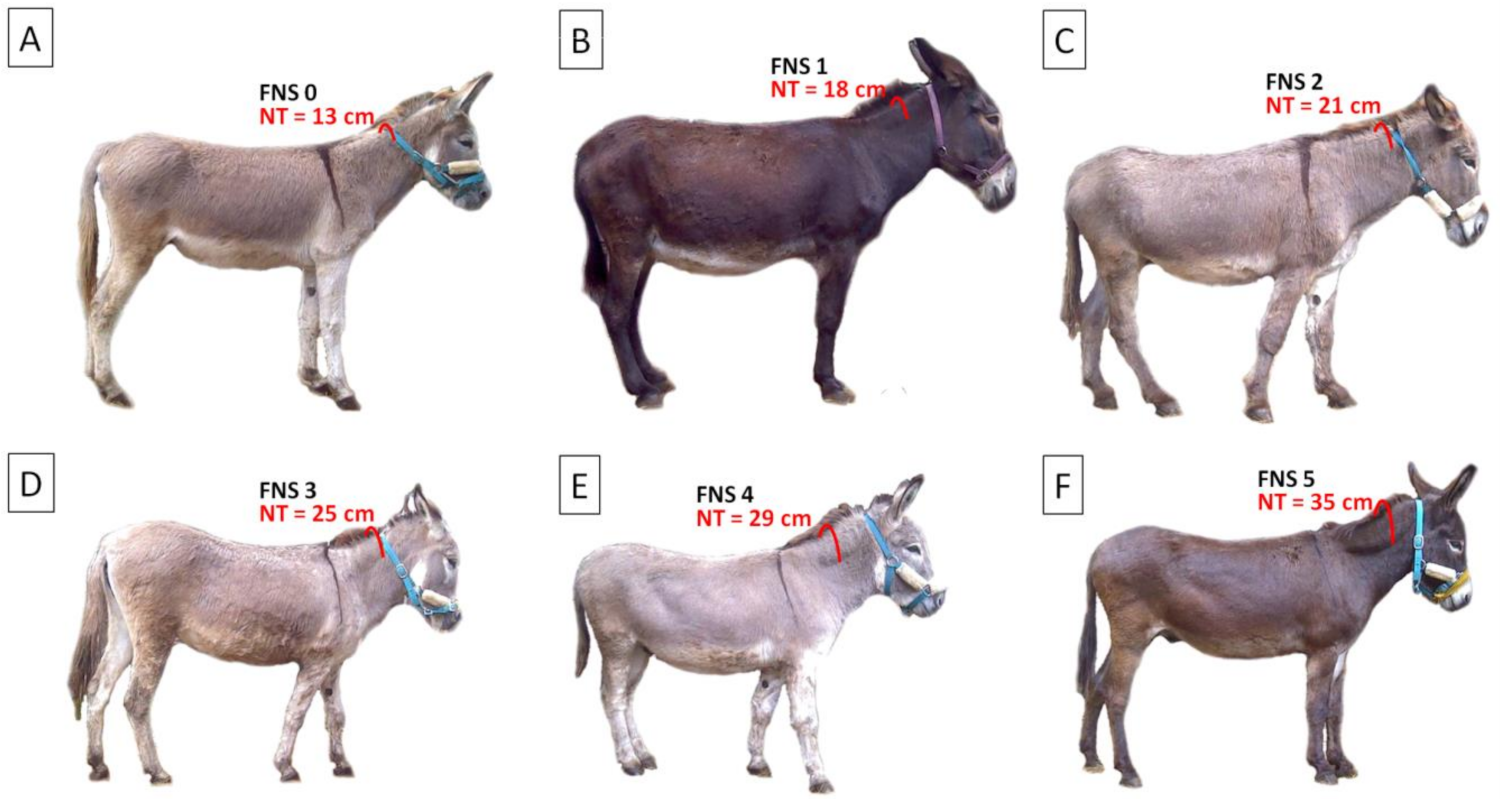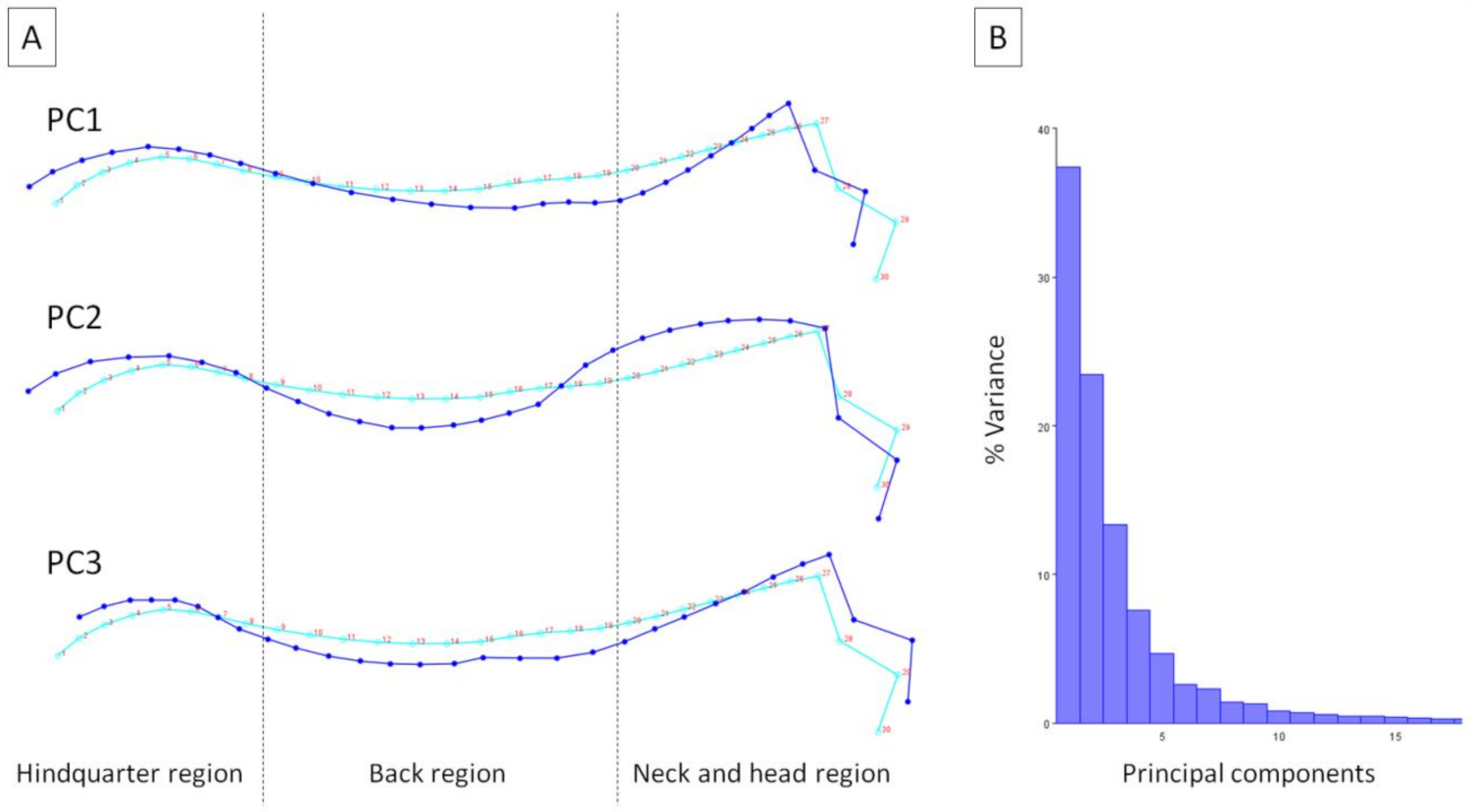Characteristics of the Donkey’s Dorsal Profile in Relation to Its Functional Body Condition Assessment
Abstract
:Simple Summary
Abstract
1. Introduction
2. Materials and Methods
2.1. Animals
2.2. Body Condition Score (BCS) Measures
2.3. Fatty Neck Score (FNS) Measures
2.4. Dental Condition Score (DCS) Measures
2.5. Photographs Collection
2.6. Geometric Morphometrics (GM) Measures
2.7. Data Analysis
3. Results
4. Discussion
5. Conclusions
Author Contributions
Funding
Institutional Review Board Statement
Data Availability Statement
Acknowledgments
Conflicts of Interest
References
- Clutton-Brock, J. Horse Power: A History of the Horse and Donkey in Human Societies; Harvard University, Press Cambridge: Cambridge, MA, USA, 1992. [Google Scholar]
- Bough, J. Donkey. Reaktion Books; LTD: London, UK, 2011. [Google Scholar]
- Borioni, N.; Marinaro, P.; Celestini, S.; Del Sole, F.; Magro, R.; Zoppi, D.; Mattei, F.; Dall Armi, V.; Mazzarella, F.; Cesario, A.; et al. Effect of equestrian therapy and onotherapy in physical and psycho-social performances of adults with intellectual disability: A preliminary study of evaluation tools based on the ICF classification. Disabil. Rehabil. 2012, 34, 279–287. [Google Scholar] [CrossRef]
- Monti, G.; Viola, S.; Baro, C.; Cresi, F.; Tovo, P.A.; Moro, G.; Ferrero, M.P.; Conti, A.; Bertino, E. Tolerability of donkey’s milk in 92 highly-problematic cow’s milk allergic children. J. Biol. Regul. Homeost. Agents. 2012, 26, 75–82. [Google Scholar]
- Valle, E.; Raspa, F.; Giribaldi, M.; Barbero, R.; Bergagna, S.; Antoniazzi, S.; Mc Lean, A.K.; Minero, M.; Cavallarin, L. A functional approach to the body condition assessment of lactating donkeys as a tool for welfare evaluation. Peer J. 2017, 5, e3001. [Google Scholar] [CrossRef] [Green Version]
- Burden, F. Practical feeding and condition scoring for donkeys and mules. Equine Vet. Educ. 2012, 24, 589–596. [Google Scholar] [CrossRef]
- Sénèque, E.; Lesimple, C.; Morisset, S.; Hausberger, M. Could posture reflect welfare state? A study using geometric morphometrics in riding school horses. PLoS ONE 2019, 14, e0211852. [Google Scholar] [CrossRef] [PubMed]
- Goodwin, D.; Levine, M.; McGreevy, P.D. Preliminary investigation of morphological differences between ten breeds of horses suggests selection for paedomorphosis. J. Appl. Anim. Welf. 2008, 11, 204–212. [Google Scholar] [CrossRef]
- Carter, R.A.; Geor, R.J.; Staniar, W.B.; Cubitt, T.A.; Harris, P.A. Apparent adiposity assessed by standardised scoring systems and morphometric measurements in horses and ponies. Vet. J. 2009, 179, 204–210. [Google Scholar] [CrossRef]
- Dugdale, A.H.A.; Curtis, G.C.; Harris, P.A.; Argo, C.M. Assessment of body fat in the pony: Part I. Relationships between the anatomical distribution of adipose tissue, body composition and body condition. Equine Vet. J. 2011, 43, 552561. [Google Scholar] [CrossRef] [PubMed]
- Fernandes, K.A.; Rogers, C.W.; Gee, E.K.; Bolwell, C.F.; Thomas, D.G. Body condition and morphometric measures of adiposity in a cohort of pony club horses and ponies in New Zealand. Proc. NZSAP 2015, 75, 195199. [Google Scholar]
- Cappai, M.G.; Picciau, M.; Pinna, W. An integrated approach towards the nutritional assessment of the Sardinian donkey: A tool for clinical nutritionists. Ital. J. Anim. Sci. 2013, 12, 182–185. [Google Scholar] [CrossRef]
- Merkies, K.; Paraschou, G.; McGreevy, P.D. Morphometric characteristics of the skull in horses and donkeys—A pilot study. Animals 2020, 10, 1002. [Google Scholar] [CrossRef] [PubMed]
- Sénèque, E.; Morisset, S.; Lesimple, C.; Hausberger, M. Testing optimal methods to compare horse postures using geometric morphometrics. PLoS ONE 2018, 13, e0204208. [Google Scholar] [CrossRef]
- Henneke, D.R.; Potter, G.D.; Kreider, J.L.; Yeates, B.F. Relationship between condition score, physical measurements and body fat percentage in mares. Equine Vet. J. 1983, 15, 371–372. [Google Scholar] [CrossRef]
- Burden, F.; Thiemann, A. Donkeys are different. J. Equine Vet. Sci. 2015, 35, 376–382. [Google Scholar] [CrossRef]
- Mendl, M.; Burman, O.H.P.; Parker, R.M.A.; Paul, E.S. Cognitive bias as an indicator of animal emotion and welfare: Emerging evidence and underlying mechanisms. Appl. Anim. Behav. Sci. 2009, 118, 161–181. [Google Scholar] [CrossRef]
- Broom, D.M. Animal welfare: Concepts and measurement. J. Anim. Sci. 1991, 69, 4167–4175. [Google Scholar] [CrossRef] [PubMed]
- Tallet, C.; Senèque, E.; Megnin, C.; Morisset, S.; Val-Laillet, D.; Meunier-Salaun, M.-C.; Fureix, C.; Hausberger, M. Assessing walking posture with geometric morphometrics: Effects of rearing environment in pigs. Appl. Anim. Behav. Sci. 2016, 174, 32–41. [Google Scholar] [CrossRef]
- Savriama, Y. A step-by-step guide for geometric morphometrics of floral symmetry. Front. Plant Sci. 2018, 9, 1433. [Google Scholar] [CrossRef] [Green Version]
- Gunz, P.; Mitteroecker, P. Semilandmarks: A method for quantifying curves and surfaces. Hystrix 2013, 24, 103–109. [Google Scholar]
- Abdi, H.; Williams, L.J. Principal component analysis. Wiley Interdiscip. Rev. 2010, 2, 433–459. [Google Scholar] [CrossRef]
- Martin Jr, B.B.; Klide, A.M. Physical examination of horses with back pain. Vet. Clin. North. Am. Equine Pract. 1999, 15, 61–70. [Google Scholar] [CrossRef]
- Davidson, E.J. Lameness evaluation of the athletic horse. Vet. Clin. Equine Pract. 2018, 34, 181–191. [Google Scholar] [CrossRef]
- Moine, S.; Flammer, S.A.; de Jesus Maia-Nussbaumer, P.; Klopfenstein Bregger, M.D.; Gerber, V. Evaluation of the effects of performance dentistry on equine rideability: A randomized, blinded, controlled trial. Vet. Q. 2017, 37, 195–199. [Google Scholar] [CrossRef] [PubMed] [Green Version]
- Pearson, R.A.; Ouassat, M. A Guide to Live Weight Estimation and Body Condition Scoring of Donkeys; Centre for Tropical Veterinary Medicine, University of Edinburgh: Edinburgh, Scotland, 2020. [Google Scholar]
- Klingenberg, C.P. MorphoJ: An integrated software package for geometric morphometrics. Mol. Ecol. Resour. 2011, 11, 353–357. [Google Scholar] [CrossRef]
- Giles, S.L.; Nicol, C.J.; Rands, S.A.; Harris, P.A. Assessing the seasonal prevalence and risk factors for nuchal crest adiposity in domestic horses and ponies using the Cresty Neck Score. BMC Vet. Res. 2015, 11, 13. [Google Scholar] [CrossRef] [PubMed] [Green Version]
- Jamdar, M.; Ema, A. A note on the vertebral formula of the donkey. Br. Vet. J. 1982, 138, 209–211. [Google Scholar] [CrossRef]
- Dyce, K.M.; Sack, W.O.; Wensing, C.J.G. The Neck, Back, and Vertebral Column of the Horse. In Textbook of Veterinary Anatomy; Saunders: Philadelphia, PA, USA, 2002. [Google Scholar]
- Burnham, S.L. Anatomical differences of the donkey and mule. Proc. AAEP 2002, 48, 102–109. [Google Scholar]
- Du Toit, N.; Gallagher, J.; Burden, F.A.; Dixon, P.M. Post mortem survey of dental disorders in 349 donkeys from an aged population (20052006). Part 1: Prevalence of specific dental disorders. Equine Vet. J. 2008, 40, 204–208. [Google Scholar] [CrossRef] [PubMed]
- Du Toit, N.; Burden, F.A.; Dixon, P.M. Clinical dental examinations of 357 donkeys in the UK. Part 2: Epidemiological studies on the potential relationships between different dental disorders, and between dental disease and systemic disorders. Equine Vet. J. 2009, 4, 395–400. [Google Scholar] [CrossRef] [PubMed]
- Mendoza, F.J.; Estepa, J.C.; Gonzalez-De Cara, C.A.; Aguilera-Aguilera, R.; Toribio, R.E.; Perez-Ecija, A. Energy-related parameters and their association with age, gender, and morphometric measurements in healthy donkeys. Vet. J. 2015, 204, 201–207. [Google Scholar] [CrossRef] [PubMed]
- Kugler, W.; Grunenfelder, H.P.; Broxham, E. Donkey Breeds in Europe; Monitoring Institute for Rare Breeds and Seeds in Europe: St. Gallen, Switzerland, 2008. [Google Scholar]
- Yılmaz, O.; Boztepe, S.; Ertuğrul, M. The domesticated donkey: II-types and breeds. Can. J. Appl. Sci. 2012, 2, 267–286. [Google Scholar]










| Centroid Size | SS | MS | df | F | p |
|---|---|---|---|---|---|
| sex | 140,716.4 | 140,716.4 | 1 | 2.77 | 0.1 |
| breed | 141,668.6 | 35,417.14 | 4 | 0.67 | 0.614 |
| BCS | 380,640.3 | 190,320.1 | 2 | 3.94 | 0.024 |
| FNS | 275,181.6 | 55,037.12 | 5 | 1.06 | 0.012 |
| DCS | 62,500.1 | 31,250.05 | 2 | 0.6 | 0.554 |
| Shape | SS | MS | df | F | p |
| sex | 0.003 | 0.00004 | 56 | 1.4 | 0.026 |
| breed | 0.012 | 0.00005 | 224 | 1.6 | <0.0001 |
| BCS | 0.023 | 0.0002 | 112 | 6.79 | <0.0001 |
| FNS | 0.039 | 0.0001 | 280 | 4.99 | <0.0001 |
| DCS | 0.008 | 0.00007 | 112 | 2.05 | <0.0001 |
| BCS 1 | BCS 2 | ||
|---|---|---|---|
| BCS 2 | MD | 4.7 | |
| PD | 0.018 | ||
| BCS 3 | MD | 7.13 | 5.23 |
| PD | 0.039 | 0.027 |
| FNS 0 | FNS 1 | FNS 2 | FNS 3 | FNS 4 | ||
|---|---|---|---|---|---|---|
| FNS 1 | MD | 7.01 | ||||
| PD | 0.018 | |||||
| FNS 2 | MD | 7.38 | 7.41 | |||
| PD | 0.022 | 0.019 | ||||
| FNS 3 | MD | 8.07 | 9.02 | 5.37 | ||
| PD | 0.037 | 0.032 | 0.017 | |||
| FNS 4 | MD | 11.75 | 13.26 | 9.91 | 8.92 | |
| PD | 0.041 | 0.044 | 0.032 | 0.026 | ||
| FNS 5 | MD | 13.99 | 16.37 | 12.83 | 10.89 | 5.54 |
| PD | 0.051 | 0.053 | 0.043 | 0.038 | 0.015 | |
| Jennets | ||
|---|---|---|
| Males | MD | 4.58 |
| PD | 0.012 | |
| AD | GSD | MFD | MPD | ||
|---|---|---|---|---|---|
| GSD | MD | 5.72 | |||
| PD | 0.01 | ||||
| MFD | MD | 6.36 | 5.6 | ||
| PD | 0.019 | 0.023 | |||
| MPD | MD | 6.65 | 6.33 | 7.03 | |
| PD | 0.013 | 0.015 | 0.028 | ||
| RD | MD | 5.37 | 5.84 | 5.24 | 6.24 |
| PD | 0.03 | 0.017 | 0.013 | 0.018 | |
| DCS 0 | DCS 1 | ||
| DCS 1 | MD | 5.36 | |
| PD | 0.016 | ||
| DCS 2 | MD | 6.4 | 5.56 |
| PD | 0.019 | 0.017 | |
Publisher’s Note: MDPI stays neutral with regard to jurisdictional claims in published maps and institutional affiliations. |
© 2021 by the authors. Licensee MDPI, Basel, Switzerland. This article is an open access article distributed under the terms and conditions of the Creative Commons Attribution (CC BY) license (https://creativecommons.org/licenses/by/4.0/).
Share and Cite
Maśko, M.; Wierzbicka, M.; Zdrojkowski, Ł.; Jasiński, T.; Pawliński, B.; Domino, M. Characteristics of the Donkey’s Dorsal Profile in Relation to Its Functional Body Condition Assessment. Animals 2021, 11, 3095. https://doi.org/10.3390/ani11113095
Maśko M, Wierzbicka M, Zdrojkowski Ł, Jasiński T, Pawliński B, Domino M. Characteristics of the Donkey’s Dorsal Profile in Relation to Its Functional Body Condition Assessment. Animals. 2021; 11(11):3095. https://doi.org/10.3390/ani11113095
Chicago/Turabian StyleMaśko, Małgorzata, Małgorzata Wierzbicka, Łukasz Zdrojkowski, Tomasz Jasiński, Bartosz Pawliński, and Małgorzata Domino. 2021. "Characteristics of the Donkey’s Dorsal Profile in Relation to Its Functional Body Condition Assessment" Animals 11, no. 11: 3095. https://doi.org/10.3390/ani11113095
APA StyleMaśko, M., Wierzbicka, M., Zdrojkowski, Ł., Jasiński, T., Pawliński, B., & Domino, M. (2021). Characteristics of the Donkey’s Dorsal Profile in Relation to Its Functional Body Condition Assessment. Animals, 11(11), 3095. https://doi.org/10.3390/ani11113095






